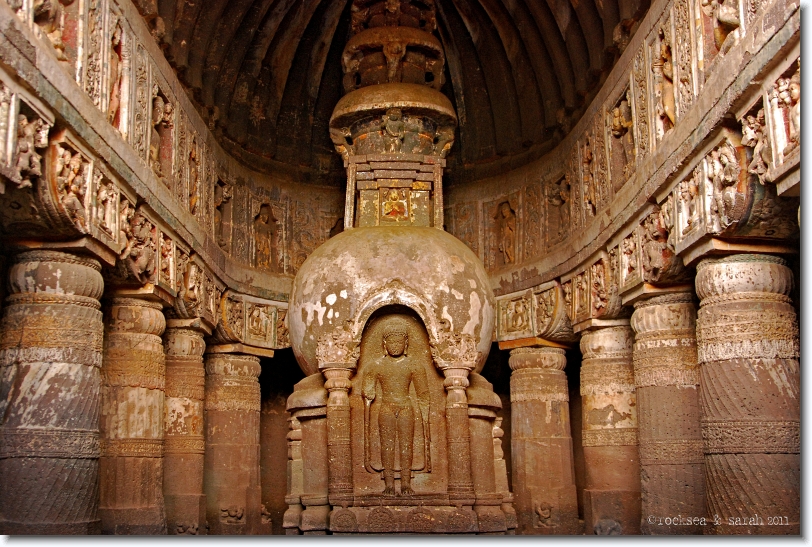Paintings of Historic Era : Classical Age

The paintings of this period are dominated by the tradition of wall paintings. The paintings of this era are present at Ajanta, Ellora, Bagh, Jogimara, Badami, Sittanavasal, Elephanta caves etc.
Ajanta
The World Heritage Site of Ajanta caves are located about 107 km from the Aurangabad district of Maharashtra, in the basin of river Bagheera. The Chinese traveller HuanTsang gives an interesting description of these caves.
In modern times James Ferguson in his monograph Rock-Cut Temples of India which 4 are Chaitya and 25 are Viharas.
These rock-cut caves were made from 200 BC to 7th century under the patronage of Shunga, Kushana, Gupta, Vakataka and Chalukya dynasties.
The oldest caves are 10, 9 and 12. Cave no 1 belongs to 7th century AD, while 16 and 17 belong to Gupta period.
 |
| Wide View Of A Late Chaitya Hall With A Stupa |
Ellora Paintings
About 97km from Ajanata, these UNESCO World Heritage paintings are located in the Ellora village. It was also known as Elapura in ancient times, which was a trade centre. There are 33 cave-structures excavated out of the vertical face of the Charanandri hills. Intial 12 caves are Budhist cave temples built between 550-750 AD. Also another 16 caves are related to Brahmanism (650-750 AD) and 5 caves are relate to Jainism (750-1000 AD). Cave no. 32 consists of images the Indra Sabha which is very remarkable. The construction of the caves started by Krishan I of the Rashtrakuta dynasty that ruled from Manyakheta is present day Karnataka state. The Great Kailasa temple is attributed to him. As is traditional in Shiva temples it has sacred bull Nandi in front of the central temple, elephants, fishes and nymphs.

Bagh Caves
Bagh caves are situated on the banks of Baghini river (a
tributary to Narmada), in Dhar district of Madhya Pradesh. They are situated on the southern slope of the Vindhyas. These caves appear to have been constructed during 6th century AD.
These caves were discovered by Dangerfield in 1818 AD. They are total nine in number. Art-historians opine them to be the successors of Ajanta and of Gupta period.
Jogimara
Jogimara is located on the hills of Raigarh, in Sarguja region of Chhattisgarh. Here the caves of Jogimara, Sita bengara and other smaller caves are located. It is among the oldest theatre of Asia. There is a large opening over the Jogimara caves, by which the natural light reached into the cave. This is also called the temple of God Varuna.
The walls of this caves contains some of the oldest wall paintings of India. Human, elephants and shark fishes are drawn on the walls of these caves. Only red, black and yellow colours had been used for the purpose of painting. The background is white everywhere. These caves are important because they are the earliet example of Indian wall paintings in historic age.
Paintings of Badami
Four rock-cut caves are belonging to Chalukya dynasty have been found in Badami, near Mumbai in Maharashtra. These were built by the king of Chalukya dynasty. Among these four caves, three caves were belong to Brahmana religion and one is dedicated to Jainism. Cave no. 3 of Vaishnava is the most important from the point view of architecture. The paintings of this cave resemble with those of Ajanta.


Sittanavasal Paintings
Sittanavasal is the famous site of an ancient Jain monastery, located in Tanjore district of Tamil Nadu. The monastery is known for housing some of the most exquisite frescoes in a rock cave. Most of these cave paintings include animals, fish, ducks, people collecting lotuses from a pond, two dancing figures etc. Apart from that, one can aslo find inscrptions dating back to the 9th and 10th centuries. The ceiling of the ardha-mandapa is adorned with murals from the 7th century.
Comments
Post a Comment